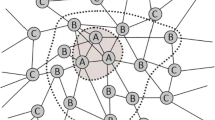Abstract
The detection of the communities and the depiction of the interactions, between the entities and the individuals in the real world network graphs is a challenging problem. There are many conventional ways to detect those interconnected nodes which lead to the detection of communities. The strength of the detected communities can be detected by its modularity which is a measurement of the structure of a graph, and increasing the modularity is also a bit challenging problem. So, in this work, the DBSCAN clustering algorithm has been implemented for the task of detecting the outliers in the process of detecting the communities in a social network, and those outliers which are also known as “noisy nodes”, are removed from the main formed network graph. The proposed algorithm in this paper, mainly focuses on the detection and removal of those noisy nodes or outliers in the detected communities which leads to the improvement of the quality of the detected communities. In previous community detection algorithms, some algorithms needed the number of communities prior to the formation of communities which precludes from forming a good community, while some algorithms cannot operate with the huge amount of data and some algorithms require a huge amount of memory. The proposed algorithm does not require any prior mentioning of the number of communities, it has also been tested with large networks with a size of more than 1000 nodes and it does not require much space. Therefore, the proposed algorithm has overcome the mentioned limitations of the previous community detection algorithms. The data have been collected from the social network websites-Facebook and Twitter. The communities formed from the proposed algorithm have been compared with the results of the four other community detection algorithms, i.e., with the Louvain algorithm, Walktrap algorithm, Leading eigenvector algorithm, and Fastgreedy algorithm. The proposed methodology performs well for the detection of communities with the increment of the strength of the detected communities.














Similar content being viewed by others
References
Ben-david S, Haghtalab N (2014) Clustering in the presence of background noise. In: Proceedings of the 31st International Conference on Machine Learning, Beijing, China, pp 280–288
Blondel VD, Guillaume JL, Lambiotte R, Lefebvre E (2008) Fast unfolding of communities in large networks. J Stat Mech Theor Exp. https://doi.org/10.1088/1742-5468/2008/10/P10008
Chamberlain BP, Kramer JL, Humby C, Deisenroth MP (2018) Real-time community detection in full social networks on a laptop. PloS One. https://doi.org/10.1371/journal.pone.0188702
Chopade P, Zhan J (2015) Structural and functional analytics for community detection in large-scale complex networks. J Big Data 2:1–28
Clauset A, Newman ME, Moore C (2004) Finding community structure in very large networks. Phys Rev E 70:066111
Dave RN (1991) Characterization and detection of noise in clustering. Pattern Recog Lett 12:657–664
Elbarawy YM, Mohamed RF, Ghali NI (2014) Improving social network community detection using DBSCAN algorithm. In: IEEE World Symposium on Computer Applications & Research (WSCAR), Sousse, Tunisia, pp 1–6
Ester M, Kriegel H, Sander J, Xu X (1996) A density-based algorithm for discovering clusters in large spatial databases with noise. In: Proceedings of the 2nd International Conference on Knowledge Discovery and Data Mining (KDD-96), Portland, Oregon, pp 226–231
Girvan M, Newman MEJ (2002) Community structure in social and biological network. Proc Natl Acad Sci 99:7821–7826
Khatoon M, Banu WA (2018) An effective way of detecting communities in social network. Int J Intel Eng Systs 11:199–211
Klein DJ (2010) Centrality measure in graphs. J Math Chem 47:1209–1223
Luxburg U (2007) A tutorial on spectral clustering. Stat Comput 17:395–416
Moreira A, Santos MY, Carneiro S (2005) Density-based clustering algorithms—DBSCAN and SNN. http://ubicomp.algoritmi.uminho.pt/local/download/SNN&DBSCAN.pdf. Accessed 25 Jul 2005
Newman M (2006) Finding community structure in networks using the eigenvectors of matrices. Phys Rev E 74:1–22
Newman MEJ, Girvan M (2004) Finding and evaluating community structure in networks. Phys Rev E 69:026113(1–15)
Orman GK, Labaut V, Cherifi H (2011) On accuracy of community structure discovery algorithms. J Converg Inf Tech 6:283–292
Pons P, Latapy M (2005) Computing communities in large networks using random walks. In: Proceedings of Computer and Information Sciences—Iscis, pp 284–293
Schubert E, Sander J, Ester M, Kriegel HP, Xu X (2017) DBSCAN revisited, revisited: why and how you should (still) use DBSCAN. ACM Trans Database Syst 42:19(1–21)
Shi J, Malik J (2000) Normalized cuts and image segmentation. IEEE PAMI 22:888–905
Snijders TAB, Nowicki K (1997) Estimation and prediction for stochastic blockmodels for graphs with latent block structure. J Classif 14:75–100
Vasudevan M, Deo N (2012) Efficient community identification in complex networks. Soc Netw Anal Min 2:345–359
Vijendra S, Shivani P (2014) Robust outlier detection technique in data mining: a univariate approach. arXiv:1406.5074
Xie J, Szymanski BK (2011) Community detection using a neighborhood strength driven label propagation algorithm. In: Network Science Workshop, IEEE, pp 188–195
Yang J, Leskovec J (2012), Defining and Evaluating Network Communities based on Ground-truth. In: Proceedings of 2012 IEEE International Conference on Data Mining (ICDM), pp 745–754
You T, Cheng HM, Ning YZ, Shia BC, Zhang ZY (2016) Community detection in complex networks using density-based clustering algorithm. Phys Stat Mech Appl 464:221–230
Zhang X, Zhu J (2013) Skeleton of weighted social network. Phys Stat Mech Appl 392:1547–1556
Acknowledgements
We are highly thankful to University Grants Commission (F1-17.1/2014-15/MANF-2014-15-MUS-WES-38675/ (SA-III/Website) & February-2015) for providing Maulana Azad National Fellowship, for conducting this research work.
Author information
Authors and Affiliations
Corresponding author
Additional information
Publisher’s Note
Springer Nature remains neutral with regard to jurisdictional claims in published maps and institutional affiliations.
Rights and permissions
About this article
Cite this article
Khatoon, M., Banu, W.A. An efficient method to detect communities in social networks using DBSCAN algorithm. Soc. Netw. Anal. Min. 9, 9 (2019). https://doi.org/10.1007/s13278-019-0554-1
Received:
Revised:
Accepted:
Published:
DOI: https://doi.org/10.1007/s13278-019-0554-1




